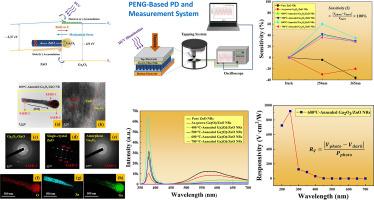Self-powered DUV photodetector harvesting piezoelectric energy in a Ga₂O₃/ZnO nanorod heterojunction
IF 7.1
Q1 ENGINEERING, CHEMICAL
引用次数: 0
Abstract
This study demonstrates the fabrication of a self-powered deep-ultraviolet (DUV) photodetector (PD) based on Ga2O3/ZnO heterostructured piezoelectric nanogenerators (PENGs), optimized through controlled thermal annealing. ZnO nanorods were synthesized via hydrothermal growth, while Ga2O3 thin films were deposited by RF magnetron sputtering, followed by annealing at 400–600 °C to modulate interfacial properties. XRD and PL spectra highlighted optimal crystallinity at 600 °C, with a dominant (002) ZnO orientation and the lowest defect to near-band-edge (NBE) emission ratio (defect ratio ≈ 0.01). Electrical characterization under 254 nm DUV illumination showed a 60 % enhancement in output voltage and 62 % in output current for 600 °C-annealed devices compared to as-prepared samples. The optimized heterostructure achieved a peak voltage responsivity of 920 V·cm2/W at 254 nm ultraviolet C (UVC) band with a photo/dark rejection ratio of 103. These results validate the synergistic effect of Ga2O3/ZnO heterojunction engineering and thermal annealing in enabling high-sensitivity, self-powered DUV photodetection for UVC monitoring applications.

在Ga₂O₃/ZnO纳米棒异质结中收集压电能量的自供电DUV光电探测器
本研究展示了基于Ga2O3/ZnO异质结构压电纳米发电机(PENGs)的自供电深紫外(DUV)光电探测器(PD)的制造,并通过受控热退火进行了优化。采用水热生长法制备ZnO纳米棒,采用射频磁控溅射法制备Ga2O3薄膜,然后在400-600℃退火以调节界面性能。XRD和PL光谱显示,在600°C时结晶度最佳,ZnO取向占主导地位(002),NBE发射比最低(缺陷比≈0.01)。254 nm DUV光照下的电特性表明,与制备样品相比,600℃退火器件的输出电压提高了60%,输出电流提高了62%。优化后的异质结构在254 nm紫外波段的峰值电压响应率为920 V·cm2/W,光/暗抑制比为103。这些结果验证了Ga2O3/ZnO异质结工程和热退火在实现用于UVC监测应用的高灵敏度、自供电DUV光探测方面的协同效应。
本文章由计算机程序翻译,如有差异,请以英文原文为准。
求助全文
约1分钟内获得全文
求助全文
来源期刊

Chemical Engineering Journal Advances
Engineering-Industrial and Manufacturing Engineering
CiteScore
8.30
自引率
0.00%
发文量
213
审稿时长
26 days
 求助内容:
求助内容: 应助结果提醒方式:
应助结果提醒方式:


